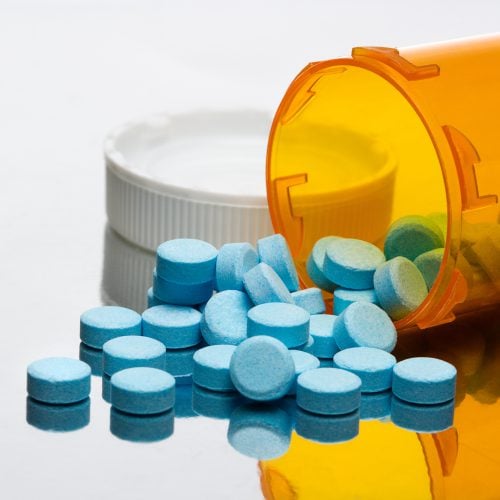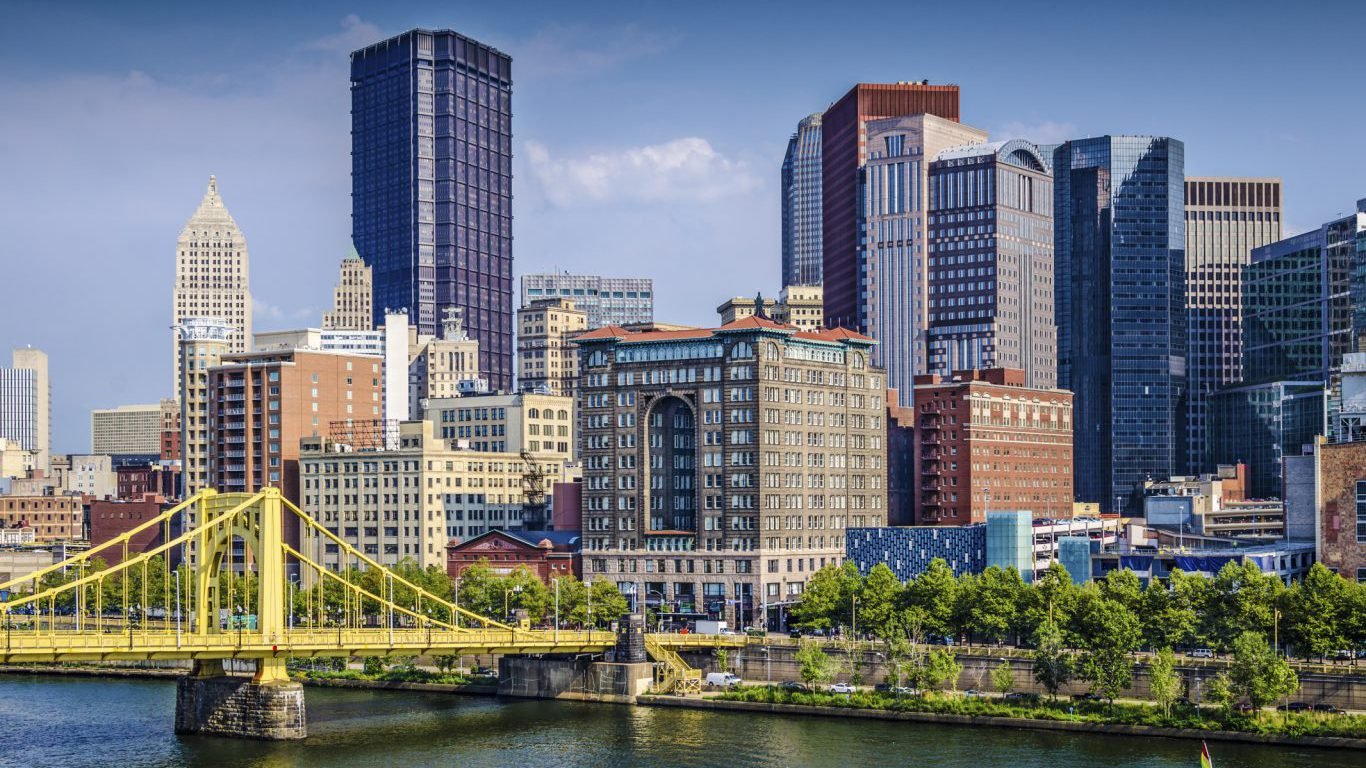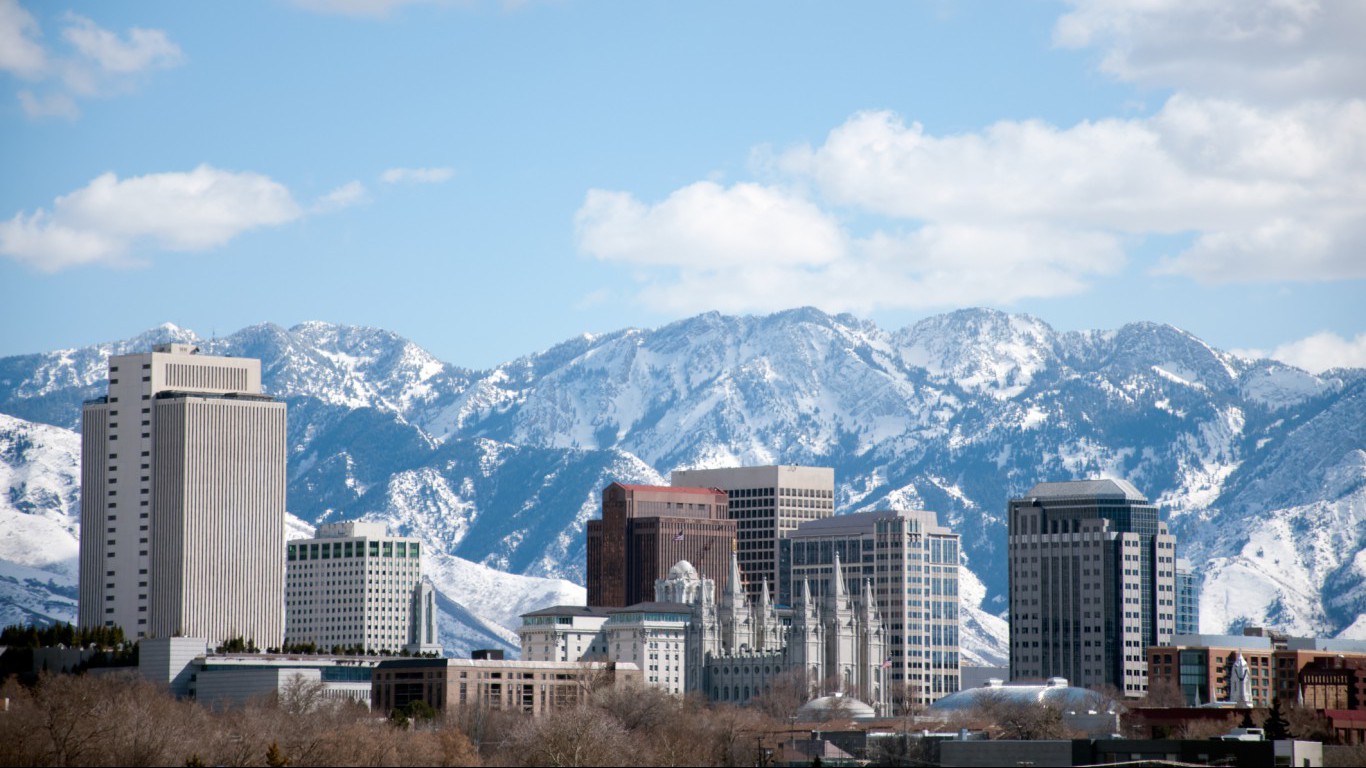
Source: Thinkstock
Fatal drug overdoses are on the rise in the United States. Specifically, deaths from heroin and other opioids have increased to the point that public health officials are calling it an epidemic. Roughly 47,000 people died of drug overdoses in 2014, the highest on record. Drug overdoses now kill more Americans each year than either automobile accidents or guns.
While few states have been immune to the alarming increase in overdose deaths in recent years, it is an even more serious problem in some parts of the country. Nationally, there were 14.7 drug deaths per 100,000 people in 2014, according to data from the Substance Abuse and Mental Health Services Administration. The drug overdose death rate was greater than 20 deaths per 100,000 people in 10 states, including West Virginia, where more than 35 people died of a drug overdose for every 100,000 residents — the worst rate in the country.
The rapid increase in overdose deaths has been alarming. Between 2000 and 2014, fatal overdoses increased by 137%. In some states with the highest rates of fatal overdoses, the rise has been even more dramatic. In West Virginia, fatal overdoses increased by 473% between 2004 and 2014, and in New Hampshire, which has the third worst fatal overdose rate, drug deaths increased by 670%.
Click here to see the 10 cities with the most drug overdoses
Heroin and opioid overdoses account for 62% of all drug deaths, and in states with the highest rates of fatal overdoses, opioids represent a disproportionately large share of drug abuse. In seven of the 10 states with the highest overdose rates, at least 40% of all people who are admitted for substance abuse treatment in a given year are addicted to heroin or other opioids, whereas the proportion is less than 25% in the majority of states.
One major cause of the recent opioid epidemic has been an increase in the abuse of prescription painkillers. Since 1999, deaths due to prescription opioids have quadrupled and today account for at least half of all opioid deaths in the United States. Many Americans first think of cocaine, heroin, crack, and methamphetamines as the biggest problem substances in this country. However, opioids other than heroin such as vicodin, oxycodone, and morphine account for between 20% and 30% of all admissions for substance abuse treatment in a number of states.
High overdose death rates afflict poor, rural places, with relatively low educational attainment just as much as they are found in wealthy, urban, more educated populations. At least on the state level, a community’s drug overdose problem is not as closely tied to social and economic conditions as many other health outcomes, such as heart disease, obesity, and cancer are.
Mental health is one factor that appears to have some relationship to both drug abuse and drug deaths. Nationally, 18.6% of adults report having suffered from some form of mental illness in the past year. In seven of the 10 states with the highest fatal overdose rates, at least 20% of adults report mental health issues.
To determine the states with the most drug overdoses, 24/7 Wall St. reviewed drug use, treatment, and overdose deaths rates per 100,000 people, from the Substance Abuse and Mental Health Services Administration, for 2014 and previous years. In addition, we considered the share of adults reporting some form of mental illness in the past 12 months, also from SAMHSA. From the FBI’s Uniform Crime Report, we reviewed drug arrest rates for 2014 and previous years.

Source: Thinkstock
10. Oklahoma
> 2014 Overdose deaths per 100,000 people: 20.3
> 2004 Overdose deaths per 100,000: 13.9 (5th highest)
> Pct. population using illicit drugs: 8.5% (19th lowest)
> Poverty rate: 16.6% (14th highest)
Like much of the country, overdose deaths in Oklahoma have risen dramatically over the past decade — from 13.9 deaths per 100,000 people in 2004 to 20.3 deaths per 100,000 people in 2014.
Heroin and other opioids are involved in the vast majority of all fatal overdoses in Oklahoma. While these drugs are among the most lethal, only a small share of drug users appear to be abusing opioids to the point of needing treatment, unlike most states on this list. Of those admitted to substance abuse treatment in the state in 2014, just 2.6% were for heroin abuse and 11.7% were for other opioids such as morphine, vicodin, and oxycodone. Meanwhile, abuse of amphetamines such as crystal meth account for 26.4% of all those admitted for treatment in a given year.

Source: Thinkstock
9. Delaware
> 2014 Overdose deaths per 100,000 people: 20.9
> 2004 Overdose deaths per 100,000: 7.6 (12th lowest)
> Pct. population using illicit drugs: 10.8% (16th highest)
> Poverty rate: 12.5% (17th lowest)
Whether it is because the state has a bigger drug problem than most states or because it has more aggressive enforcement, Delaware has the highest rate of drug-related arrests in the country. While there were less than 500 drug-related arrests per 100,000 U.S. residents in 2014, there were 659 such arrests in delaware per 100,000 residents. Drug arrests are also rising dramatically in the state. Only in 2004, Delaware’s drug arrest rate was just 393 per 100,000 people.
Like many of the states with the highest rates of overdose death, heroin and other opioids appear to be a disproportionately large problem in Delaware, accounting for more than half of all individuals admitted for treatment annually.

Source: Thinkstock
8. Pennsylvania
> 2014 Overdose deaths per 100,000 people: 21.9
> 2004 Overdose deaths per 100,000: 12.7 (10th highest)
> Pct. population using illicit drugs: 9.1% (25th lowest)
> Poverty rate: 13.6% (21st lowest)
Drug overdose deaths have risen at an alarming rate in Pennsylvania, increasing 14 fold in the past 35 years, according to a recently published study by the University of Pittsburgh Graduate School of Public Health. The state has the eighth highest rate of drug overdose deaths in the country, with 21.9 deaths per 100,000 residents a year.
As is the case with many states, prescription painkillers and heroin appear to be the greatest source of this state crisis, accounting for nearly half of all rehabilitation admissions each year, with heroin abuse alone accounting for 37.8% of all admissions, the third highest share compared to other states.

Source: Thinkstock
7. Utah
> 2014 Overdose deaths per 100,000 people: 22.4
> 2004 Overdose deaths per 100,000: 16.3 (3rd highest)
> Pct. population using illicit drugs: 7.7% (8th lowest)
> Poverty rate: 11.7% (11th lowest)
Utah’s drug overdose death rate of 22.4 per 100,000 residents is much higher than the national rate is 14.7 deaths per 100,000 people. Perhaps more alarming is that the high death rate is widespread across the state. The rate is at least 20 overdose deaths per 100,000 people in 60% of counties, the second largest share in the U.S.
The state has an abnormally high rate of mental illness, a risk factor for substance abuse and overdose. An estimated 22% of the population reported suffering from mental illness at some point in the past year, the second highest proportion in the country.

Source: Wikimedia Commons
6. Rhode Island
> 2014 Overdose deaths per 100,000 people: 23.4
> 2004 Overdose deaths per 100,000: 9.8 (22nd highest)
> Pct. population using illicit drugs: 14.4% (4th highest)
> Poverty rate: 14.3% (24th lowest)
Abuse of heroin and other opioids such as prescription painkillers, as well as overdose from such drugs, is on the rise in the United States. These drugs already account for the vast majority of overdose deaths nationwide. In Rhode island, which has one of the highest rates of fatal overdoses in the country, opioids appear to be an even more serious problem. While in the majority of states, less than 100 people per 100,000 are admitted for treatment for heroin and opioid addiction, the rate is 474.4 per 100,000 people a year in Rhode Island, the sixth highest rate of all states.
In response to a recent update to the number of accidental overdose deaths in the state, former director of the Rhode Island department of Health Michael Fine explained that the problem was not just the difficulty of treating overdoses in time, but also the high rate of drug use in the state. Indeed, the state has a reported rate of illicit drug use of nearly 15% among those 12 years and older, the fourth-highest rate in the United States.

Source: Thinkstock
> 2014 Overdose deaths per 100,000 people: 24.6
> 2004 Overdose deaths per 100,000: 9.9 (20th highest)
> Pct. population using illicit drugs: 8.7% (21st lowest)
> Poverty rate: 15.8% (20th highest)
Ohio’s fatal overdose rate has skyrocketed in the past decade, increasing from less than 10 deaths per 100,000 people in 2004 to nearly 25 deaths per 100,000 people in 2014. This roughly 150% increase was the fourth largest increase among all states.
Of the 46,000 Ohio residents admitted for substance abuse treatment in the state in 2014, roughly 27% were heroin addicts and another 10% required treatment for other opioids, including prescription painkillers. In an effort to help curb opioid deaths and other overdoses, the state has recently passed a law that includes a “good Samaritan”clause, which means those reporting a drug overdose are immune from prosecution.

Source: Thinkstock
4. Kentucky
> 2014 Overdose deaths per 100,000 people: 24.7
> 2004 Overdose deaths per 100,000: 12.8 (8th highest)
> Pct. population using illicit drugs: 8.4% (17th lowest)
> Poverty rate: 19.1% (5th highest)
There are roughly 25 accidental overdoses each year in Kentucky for every 100,000 people, the fourth worst rate of all states. Like most states where fatal overdoses are relatively common, Kentucky has a disproportionately serious problem with heroin and other opioids, which cause the majority of accidental fatal overdoses in the United States. Roughly 45% of all people who enter treatment for substance abuse in the state do so for opioid abuse, the eighth highest proportion in the country.
One factor contributing to Kentucky’s high overdose rate is fentanyl, a synthetic opioid that is particularly dangerous when used improperly. The rate of fentanyl deaths has more than doubled in the state past year.

Source: Wikimedia Commons
3. New Hampshire
> 2014 Overdose deaths per 100,000 people: 26.2
> 2004 Overdose deaths per 100,000: 9.6 (24th highest)
> Pct. population using illicit drugs: 12.7% (9th highest)
> Poverty rate: 9.2% (the lowest)
Only Delaware has seen a more rapid rise in fatal overdoses in the past decade than New Hampshire. In 2014, there were 26.2 deaths per 100,000 people, compared to 9.6 per 100,000 people a decade earlier. Mental illness is a key indicator of the potential for substance abuse, and New Hampshire has one of the highest rates of such disorders in the country. More than 21% of New Hampshire adults reported suffering from some form of mental illness in the past year, the fifth-highest share in the country.
New Hampshire’s drug use rate is one of the highest of all states. While less than 10% of U.S. residents 12 years and older report some form of illicit drug use in the past year, 12.7% of New Hampshire’s population 12 and older reports the same, the ninth-highest rate in the United States.

Source: Wikimedia Commons
2. New Mexico
> 2014 Overdose deaths per 100,000 people: 27.3
> 2004 Overdose deaths per 100,000: 16.9 (2nd highest)
> Pct. population using illicit drugs: 11.0% (14th highest)
> Poverty rate: 21.3% (2nd highest)
New Mexico has the second highest drug overdose rate of any state, and like much of the country, that rate is on the rise. The number of fatal overdoses rose from 22.6 per 100,000 people in 2013 to 27.3 per 100,000 in 2014. Just 10 years ago, only 6% of the state’s counties had an overdose rate greater than 20 deaths per 100,000 people. Now, 72.7% of the state’s counties have at least that rate of fatal overdose.
In 2014, there were 23 separate pharmacy robberies in the state. These are often perpetrated by those seeking to acquire and sell prescription painkillers. These drugs can eventually find their way into the hands of state residents, and the robberies may contribute to higher rates of abuse in the state.

Source: Thinkstock
1. West Virginia
> 2014 Overdose deaths per 100,000 people: 35.5
> 2004 Overdose deaths per 100,000: 18.8 (the highest)
> Pct. population using illicit drugs: 7.7% (7th lowest)
> Poverty rate: 18.3% (7th highest)
No state has a higher overdose death rate than West Virginia, where in a given year there are 35 drug-related deaths per 100,000 people. That is nearly a 90% increase from just a decade ago. This increase is due at least in part to a rise in abuse of the synthetic opioid fentanyl. Fatal overdoses from the extremely powerful painkiller nearly tripled in the past year alone.
More than one quarter of people admitted for treatment for substance abuse in the state are suffering from addiction to opioids other than heroin. West Virginia, not surprisingly, has the third highest painkiller prescription rate in the country, at 137 prescriptions per 100,000 people, compared to a U.S. rate of just 82.5 prescriptions per 100,000 people.
Essential Tips for Investing: Sponsored
A financial advisor can help you understand the advantages and disadvantages of investment properties. Finding a qualified financial advisor doesn’t have to be hard. SmartAsset’s free tool matches you with up to three financial advisors who serve your area, and you can interview your advisor matches at no cost to decide which one is right for you. If you’re ready to find an advisor who can help you achieve your financial goals, get started now.
Investing in real estate can diversify your portfolio. But expanding your horizons may add additional costs. If you’re an investor looking to minimize expenses, consider checking out online brokerages. They often offer low investment fees, helping you maximize your profit.
Thank you for reading! Have some feedback for us?
Contact the 24/7 Wall St. editorial team.

